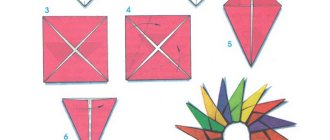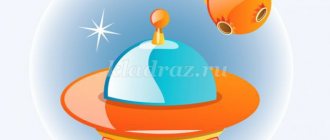Summary of the final lesson for children of the first junior group “Spring walk”
Purpose of the lesson: activation of cognitive and speech activity of children.
Tasks:
- consolidate knowledge about spring;
- consolidate knowledge about color;
- clarify the concepts: one - many, wide - narrow;
- development of interest in game improvisations.
Planned result: has a basic understanding of spring, knows four primary colors; participates with interest in outdoor games and game improvisations.
Materials: wide and narrow path, cubes, hoop, duck with ducklings, bear, flowers (yellow, red, green, blue), hedgehog, basket.
Progress of the lesson
- Children, remember what time of year it is now? (Spring)
- That's right, spring. Why is it warm in spring? (Because the sun is shining)
- Let's sing a song about the sun:
Sunshine, sunshine, shine brighter for us, Flowers will bloom on the lawn. Sunshine, sunshine, shine brighter for us, All the guys will weave wreaths.
- I heard that flowers have already grown in the forest and I want to invite you for a walk in the forest. Can you help me find flowers? (Yes).
- We will decorate our group with them. Let's take a basket for them and go into the forest together.
- Look! What is this? (This is a stream).
- What is it: wide or narrow? (Narrow)
- What should we do with you? How to get over it? (You can jump over it).
- That's right, first I'll jump over, and then you. (jump over)
- And then there’s the river. What is she like? (Wide).
- Can you jump over it? (No).
- And why? (It's wide).
- We will cross it on pebbles. How many are there? (A lot of).
- How should you go across the river? (Carefully)
- And why? (You can get your feet wet).
- What happens if we get our feet wet? (We'll get sick)
- We will cross the river carefully, I will go first, and you will follow me. (Move over)
- What is it? Yes, this is a lake! What is it like? (Round)
- And who is this? (Duck with ducklings)
- How many ducks? (One)
- What about the ducklings? (A lot of).
- What are they doing? (They swim).
- And then someone else hid from us. And he growls at us too. Who is this? (Bear)
- Yes, it's a bear. What did the bear do in winter? (Slept)
- Bear, bear, couch potato, he slept long and deeply.
He slept through the whole winter, and spring came, he woke up and wants to play with us. Shall we play with him? (Yes)
P.I. "Brown bear"
- Now let's say goodbye to the bear. Goodbye, bear. It's time for us to move on.
- Have you forgotten where we are going? (For flowers).
- Where are they? Here is a clearing, and there are flowers on it. There are so many of them. Let's smell them, let's smell them. (Inhale through your nose, exhale through your mouth/ 3-4 times)
- Now let's collect flowers. First we will collect the red ones, and then the yellow, green, and blue ones. Let's put them in the basket.
- How many flowers do we have in the basket? (A lot of)
- Hear, someone is puffing here for a stump. Look, it's a hedgehog.
Like a bear, he slept all winter, and woke up in the spring. Touch it. What is he like? (Barbed)
- What a prickly hedgehog
He looks like a Christmas tree
It has needles like our Christmas tree.
- Let's turn into hedgehogs and curl up into balls:
Here's a hedgehog curled up in a ball because he's cold
The hedgehog's ray touched
The hedgehog stretched once
He smiled, smiled and stretched again.
- These are the wonderful hedgehogs we were! Now let’s turn back into kids and go back to kindergarten.
Let's take our basket of flowers and go: past the lake, across the river, through the stream. So we came to kindergarten.
— Did you enjoy walking through the forest?
— What did you like most?
Andreeva Nadezhda Anatolyevna Teacher, MBDOU kindergarten No. 97, Kamensk-Uralsky, Sverdlovsk region, Russia.
The material is published in the author's edition
Summary of the walk in the second junior group “Spring. Observation of the birch"
Summary of a walk in the second junior group
"Spring. Observation of the birch"
Integration of educational areas: “Socio-communicative development”, “Speech development”, “Cognitive development”, “Physical development”
Goal: To continue acquaintance of children with the trees of their native land, to expand children’s knowledge about the birch tree. Objectives: 1. To arouse children’s interest in a specific object - a tree. Learn to name the individual parts of a tree. Find the distinctive features of birch from other trees. 2. Develop in children a desire to observe, explore, and gain new knowledge. 3. Enrich children's vocabulary with adjectives.
Progress of the walk: 1. Observation of inanimate nature. The teacher reads the poem: The sun does not frown, does not take its eyes off you. Because the sun
We like it!
-Who else does it keep its eyes on? Do you want to know? (intriguing pause) - I’ll show you with my hands, and you try to guess (riddle - action)
- But we don’t have one tree, there are many of them. Now we will come to one of them. The teacher approaches the birch tree with the children
-Which tree did we come to?
They scattered along the edge of the forest
Girlfriends in white dresses. (Birches)
-How did you know that it was a birch?
-What color is the trunk of a birch tree? (white)
She waited for us for so long, watched us play. What will we tell her? (children say hello)
-Guys, what do you think is the mood of our birch tree? Why? - Do you remember when we compared a tree with a person? - We have a torso. And what is the body of the tree? (trunk)
Come and stroke him, the birch tree will be pleased. — What kind of trunk does our birch have: rough or smooth? warm or cold? hard or soft? - Now, Dima, try to pull the tree out of the ground. Now Sasha, Olesya... - Why couldn’t you do it? (the tree holds onto the ground with its roots) - If the trunk of a tree is the body, then what are the roots? (legs) - We have hands. How many are there? - How much does a birch tree have? What is this? (twigs) - Where are the fingers? (buds) - I will carefully tilt the branch, and you and I will look at them carefully. - What kind of buds does a birch have? Touch them. What can you say about the kidney? (she's small)
- What is the tip of the kidney? (acute) - In our group, leaves appeared from the buds. Why aren't they here yet? (it’s still cold outside) - You and I will continue to watch the kidneys and find out what happens to them. Now let's play. 2. Outdoor game:
"1,2,3 - run to the tree"
Goal: remind children of the names of objects and some trees (birch, Christmas tree); strengthen the ability to run in a flock.
Children stand near the teacher and listen to what he says.
- 1,2,3- run to the sandbox (children run in a flock to the sandbox)
- 1,2,3 - run to the birch tree! Etc.
3. Individual work
Individual work with Dima, Stepa, Nastya on the development of the “Jump over the stream” movements.
Goal: Practice jumping on two legs while moving forward.
- Be careful, Dima, the stream is deep, you can get your feet wet.
4. Labor
Goal: To educate children in their work activities, to teach them to maintain order and cleanliness. Encourage to provide assistance to adults, to cultivate a caring attitude towards the results of work.
Equipment: Bucket.
Methodological techniques: praise, encouragement, example.
-Children, do you know what needs to be done to keep the area clean?
-That's right, clean up.
-Do you want our area to be clean? (Yes)
- Oh, what great guys. To keep our area clean, we need to collect twigs in this bucket.
- Nikita, Lera and Ksyusha, what great fellows, have already gotten to work.
“Whoever finds twigs on the site, put them in this bucket.”
- Roma is great, he’s trying. Our place will be clean and clean.
- Children, look how clean our area has become.
— Did you enjoy cleaning?
- Thank you for helping me clean up, well done!
5. Independent activity of children.
Goal: to develop the ability to perform actions in game exercises, play on topics from the surrounding life.
Return to the group
We were walking, we were tired,
So it’s time for us to join the group,
The nanny left at lunch,
Let's eat soup, friends.
Get text



